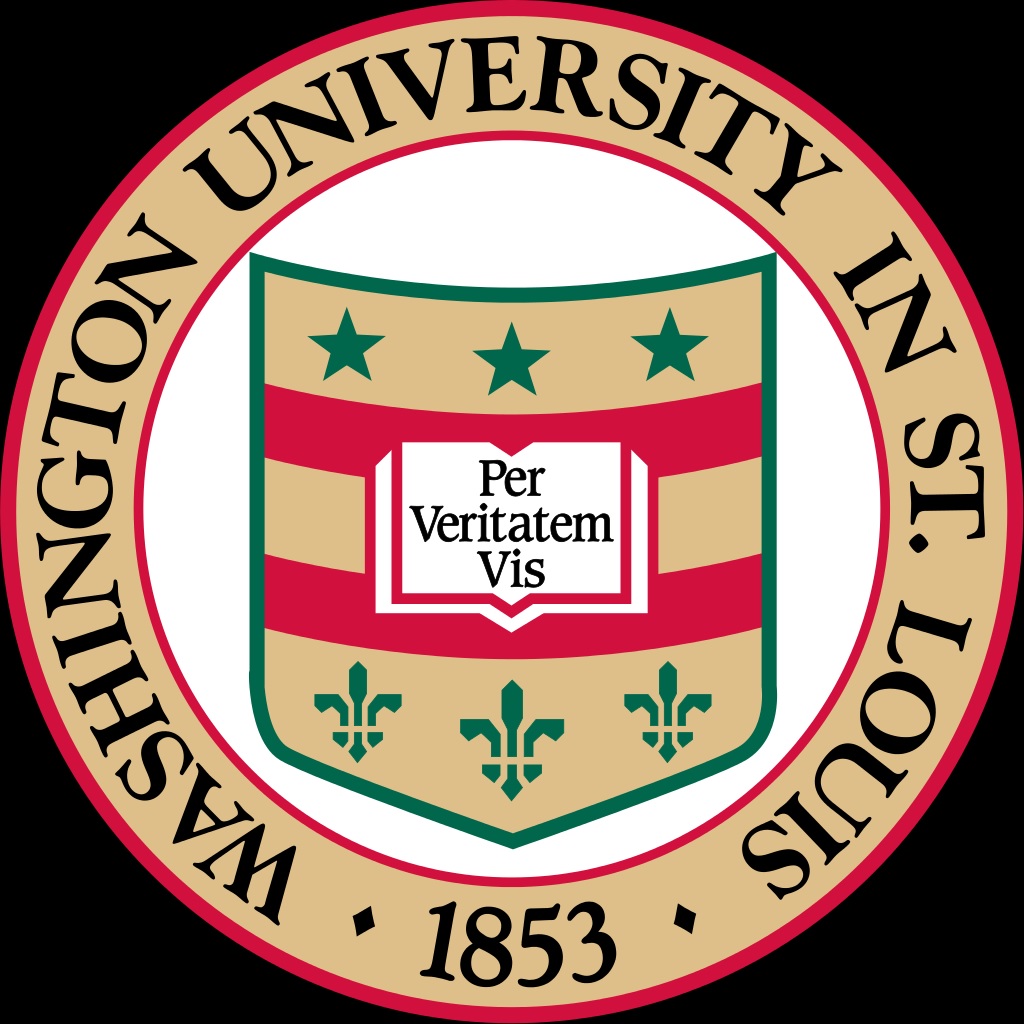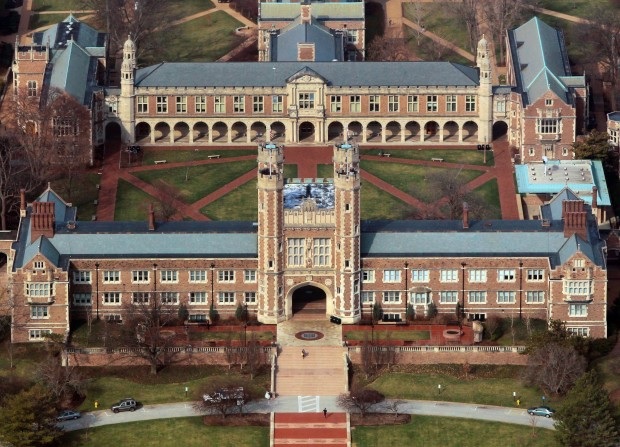From The Washington University in St. Louis
3.29.23 [Just today in social media.]
Talia Ogliore
talia.ogliore@wustl.edu
Intrigued by reports of recent volcanic eruptions on Venus? WashU planetary scientists Paul Byrne and Rebecca Hahn want you to use their new map of 85,000 volcanoes on Venus to help locate the next active lava flow.
“This paper provides the most comprehensive map of all volcanic edifices on Venus ever compiled,” said Byrne, an associate professor of earth and planetary sciences in Arts & Sciences at Washington University in St. Louis. “It provides researchers with an enormously valuable database for understanding volcanism on that planet — a key planetary process, but for Venus is something about which we know very little, even though it’s a world about the same size as our own.”
Byrne and Hahn used radar imagery from NASA’s Magellan mission to Venus to catalog volcanoes across Venus at a global scale.

Their resulting database contains 85,000 volcanoes, about 99% of which are less than 3 miles (5 km) in diameter.
Their study was posted online ahead of print in JGR Planets [below].
“Since NASA’s Magellan mission in the 1990s, we’ve had numerous major questions about Venus’ geology, including its volcanic characteristics,” Byrne said. “But with the recent discovery of active volcanism on Venus [Science (below)], understanding just where volcanoes are concentrated on the planet, how many there are, how big they are, etc., becomes all the more important — especially since we’ll have new data for Venus in the coming years.”
“We came up with this idea of putting together a global catalog because no one’s done it at this scale before,” said Hahn, a graduate student in earth and planetary sciences at Washington University, first author of the new paper. “It was tedious, but I had experience using ArcGIS software, which is what I used to build the map. That tool wasn’t available when these data first became available back in the ’90s.
“People back then were manually hand-drawing circles around the volcanoes, when I can just do it on my computer.”
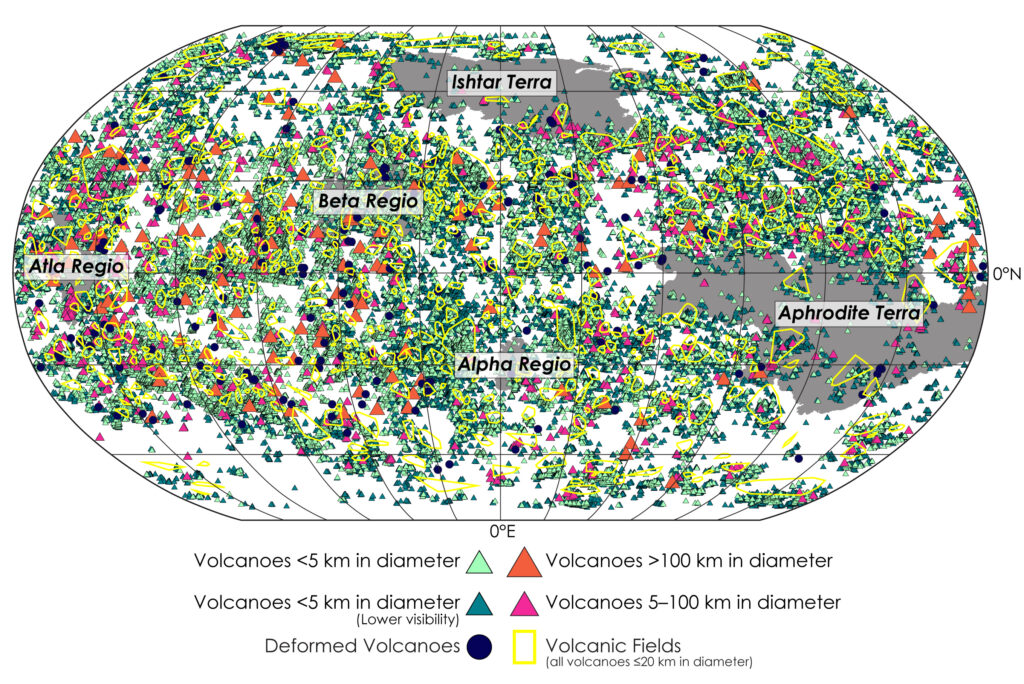
A new paper in JGR Planets provides the most comprehensive map of all volcanic edifices on Venus ever compiled. (Map created by Rebecca Hahn, Washington University in St. Louis)
“This new database will enable scientists to think about where else to search for evidence of recent geological activity,” said Byrne, who is a faculty fellow of the university’s McDonnell Center for the Space Sciences. “We can do it either by trawling through the decades-old Magellan data (as the new Science paper did) or by analyzing future data and comparing it with Magellan data.”
Byrne and Hahn’s new study includes detailed analyses of where volcanoes are, where and how they’re clustered, and how their spatial distributions compare with geophysical properties of the planet such as crustal thickness.
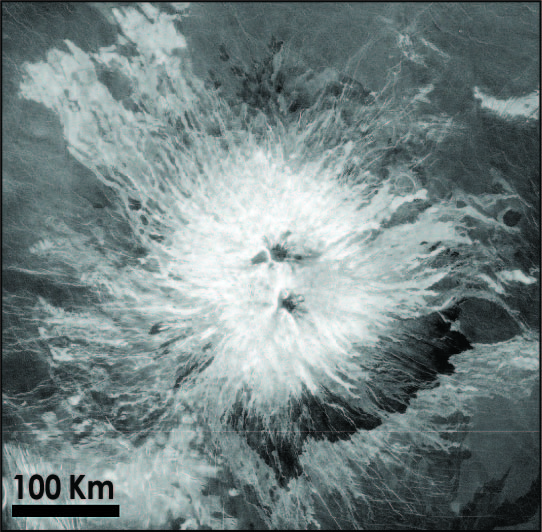
Sapas Mons, a large volcano on Venus, is about 400 km in diameter. It was imaged by the Magellan spacecraft, with a light source coming from the left side of the image. (Image courtesy of JGR Planets)
Taken together, this work provides the most comprehensive understanding of Venus’ volcanic properties — and perhaps of any world’s volcanism so far.
That’s because, although we know a great deal about the volcanoes on Earth that are on land, there are still likely a great many yet to be discovered under the oceans. Lacking oceans of its own, Venus’ entire surface can be viewed with Magellan radar imagery.
Although there are volcanoes across almost the entire surface of Venus, the scientists found relatively fewer volcanoes in the 20-100 km diameter range, which may be a function of magma availability and eruption rate, they surmise.
Byrne and Hahn also wanted to take a closer look at smaller volcanoes on Venus, those less than 3 miles across that have been overlooked by previous volcano hunters.
“They’re the most common volcanic feature on the planet: they represent about 99% of my dataset,” Hahn said. “We looked at their distribution using different spatial statistics to figure out whether the volcanoes are clustered around other structures on Venus, or if they’re grouped in certain areas.”
The new volcanoes dataset is hosted at Washington University and publicly available for other scientists to use.
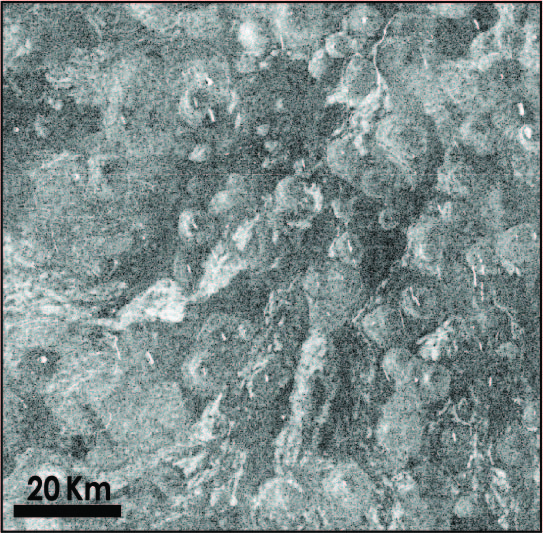
Smaller volcanoes on the surface of Venus — like those clustered here — are harder to detect, but make up about 99% of the volcanic edifices tracked in a new, comprehensive volcano database from Washington University scientists. These volcanoes were imaged by the Magellan spacecraft with a light source coming from the left of the image. (Image courtesy of JGR Planets)
“We’ve already heard from colleagues that they’ve downloaded the data and are starting to analyze it — which is exactly what we want,” Byrne said. “Other people will come up with questions we haven’t, about volcano shape, size, distribution, timing of activity in different parts of the planet, you name it. I’m excited to see what they can figure out with the new database!”
And if 85,000 volcanoes on Venus seems like a large number, Hahn said it’s actually conservative. She believes there are hundreds of thousands of additional geologic features that have some volcanic properties lurking on the surface of Venus. They’re just too small to get picked up.
“A volcano 1 kilometer in diameter in the Magellan data would be 7 pixels across, which is really hard to see,” Hahn said. “But with improved resolution, we could be able to resolve those structures.”
And it’s exactly that kind of data that future missions to Venus will acquire in the 2030s.
“NASA and ESA (the European Space Agency) are each sending a mission to Venus in the early 2030s to take high-resolution radar images of the surface,” Byrne said. “With those images, we’ll be able to search for those smaller volcanoes we predict are there.
“This is one of the most exciting discoveries we’ve made for Venus — with data that are decades old!” Byrne said. “But there are still a huge number of questions we have for Venus that we can’t answer, for which we have to get into the clouds and onto the surface.
“We’re just getting started,” he said.
See the full article here .
Comments are invited and will be appreciated, especially if the reader finds any errors which I can correct. Use “Reply”.
five-ways-keep-your-child-safe-school-shootings
Please help promote STEM in your local schools.
The Washington University in St. Louis is a private research university in Greater St. Louis with its main campus (Danforth) mostly in unincorporated St. Louis County, Missouri, and Clayton, Missouri. It also has a West Campus in Clayton, North Campus in the West End neighborhood of St. Louis, Missouri, and Medical Campus in the Central West End neighborhood of St. Louis, Missouri.
Founded in 1853 and named after George Washington, the university has students and faculty from all 50 U.S. states and more than 120 countries. Washington University is composed of seven graduate and undergraduate schools that encompass a broad range of academic fields. To prevent confusion over its location, the Board of Trustees added the phrase “in St. Louis” in 1976. Washington University is a member of the Association of American Universities and is classified among “R1: Doctoral Universities – Very high research activity”.
As of 2020, 25 Nobel laureates in economics, physiology and medicine, chemistry, and physics have been affiliated with Washington University, ten having done the major part of their pioneering research at the university. In 2019, Clarivate Analytics ranked Washington University 7th in the world for most cited researchers. The university also received the 4th highest amount of National Institutes of Health medical research grants among medical schools in 2019.
Washington University was conceived by 17 St. Louis business, political, and religious leaders concerned by the lack of institutions of higher learning in the Midwest. Missouri State Senator Wayman Crow and Unitarian minister William Greenleaf Eliot, grandfather of the poet T.S. Eliot, led the effort.
The university’s first chancellor was Joseph Gibson Hoyt. Crow secured the university charter from the Missouri General Assembly in 1853, and Eliot was named President of the Board of Trustees. Early on, Eliot solicited support from members of the local business community, including John O’Fallon, but Eliot failed to secure a permanent endowment. Washington University is unusual among major American universities in not having had a prior financial endowment. The institution had no backing of a religious organization, single wealthy patron, or earmarked government support.
During the three years following its inception, the university bore three different names. The board first approved “Eliot Seminary,” but William Eliot was uncomfortable with naming a university after himself and objected to the establishment of a seminary, which would implicitly be charged with teaching a religious faith. He favored a nonsectarian university. In 1854, the Board of Trustees changed the name to “Washington Institute” in honor of George Washington, and because the charter was coincidentally passed on Washington’s birthday, February 22. Naming the university after the nation’s first president, only seven years before the American Civil War and during a time of bitter national division, was no coincidence. During this time of conflict, Americans universally admired George Washington as the father of the United States and a symbol of national unity. The Board of Trustees believed that the university should be a force of unity in a strongly divided Missouri. In 1856, the university amended its name to “Washington University.” The university amended its name once more in 1976, when the Board of Trustees voted to add the suffix “in St. Louis” to distinguish the university from the over two dozen other universities bearing Washington’s name.
Although chartered as a university, for many years Washington University functioned primarily as a night school located on 17th Street and Washington Avenue in the heart of downtown St. Louis. Owing to limited financial resources, Washington University initially used public buildings. Classes began on October 22, 1854, at the Benton School building. At first the university paid for the evening classes, but as their popularity grew, their funding was transferred to the St. Louis Public Schools. Eventually the board secured funds for the construction of Academic Hall and a half dozen other buildings. Later the university divided into three departments: the Manual Training School, Smith Academy, and the Mary Institute.
In 1867, the university opened the first private nonsectarian law school west of the Mississippi River. By 1882, Washington University had expanded to numerous departments, which were housed in various buildings across St. Louis. Medical classes were first held at Washington University in 1891 after the St. Louis Medical College decided to affiliate with the university, establishing the School of Medicine. During the 1890s, Robert Sommers Brookings, the president of the Board of Trustees, undertook the tasks of reorganizing the university’s finances, putting them onto a sound foundation, and buying land for a new campus.
In 1896, Holmes Smith, professor of Drawing and History of Art, designed what would become the basis for the modern-day university seal. The seal is made up of elements from the Washington family coat of arms, and the symbol of Louis IX, whom the city is named after.
Washington University spent its first half century in downtown St. Louis bounded by Washington Ave., Lucas Place, and Locust Street. By the 1890s, owing to the dramatic expansion of the Medical School and a new benefactor in Robert Brookings, the university began to move west. The university board of directors began a process to find suitable ground and hired the landscape architecture firm Olmsted, Olmsted & Eliot of Boston. A committee of Robert S. Brookings, Henry Ware Eliot, and William Huse found a site of 103 acres (41.7 ha) just beyond Forest Park, located west of the city limits in St. Louis County. The elevation of the land was thought to resemble the Acropolis and inspired the nickname of “Hilltop” campus, renamed the Danforth campus in 2006 to honor former chancellor William H. Danforth.
In 1899, the university opened a national design contest for the new campus. The renowned Philadelphia firm Cope & Stewardson (same architects who designed a large part of The University of Pennsylvania and Princeton University) won unanimously with its plan for a row of Collegiate Gothic quadrangles inspired by The University of Oxford (UK) and The University of Cambridge (UK). The cornerstone of the first building, Busch Hall, was laid on October 20, 1900. The construction of Brookings Hall, Ridgley, and Cupples began shortly thereafter. The school delayed occupying these buildings until 1905 to accommodate the 1904 World’s Fair and Olympics. The delay allowed the university to construct ten buildings instead of the seven originally planned. This original cluster of buildings set a precedent for the development of the Danforth Campus; Cope & Stewardson’s original plan and its choice of building materials have, with few exceptions, guided the construction and expansion of the Danforth Campus to the present day.
By 1915, construction of a new medical complex was completed on Kingshighway in what is now St. Louis’s Central West End. Three years later, Washington University admitted its first women medical students.
In 1922, a young physics professor, Arthur Holly Compton, conducted a series of experiments in the basement of Eads Hall that demonstrated the “particle” concept of electromagnetic radiation. Compton’s discovery, known as the “Compton Effect,” earned him the Nobel Prize in physics in 1927.
During World War II, as part of the Manhattan Project, a cyclotron at Washington University was used to produce small quantities of the newly discovered element plutonium via neutron bombardment of uranium nitrate hexahydrate. The plutonium produced there in 1942 was shipped to the Metallurgical Laboratory Compton had established at The University of Chicago where Glenn Seaborg’s team used it for extraction, purification, and characterization studies of the exotic substance.
After working for many years at the University of Chicago, Arthur Holly Compton returned to St. Louis in 1946 to serve as Washington University’s ninth chancellor. Compton reestablished the Washington University football team, making the declaration that athletics were to be henceforth played on a “strictly amateur” basis with no athletic scholarships. Under Compton’s leadership, enrollment at the university grew dramatically, fueled primarily by World War II veterans’ use of their GI Bill benefits.
In 1947, Gerty Cori, a professor at the School of Medicine, became the first woman to win a Nobel Prize in Physiology or Medicine.
 Cray Cori II supercomputer at National Energy Research Scientific Computing Center(US) at DOE’s Lawrence Berkeley National Laboratory, named after Gerty Cori, the first American woman to win a Nobel Prize in science.
Cray Cori II supercomputer at National Energy Research Scientific Computing Center(US) at DOE’s Lawrence Berkeley National Laboratory, named after Gerty Cori, the first American woman to win a Nobel Prize in science.
Professors Carl and Gerty Cori became Washington University’s fifth and sixth Nobel laureates for their discovery of how glycogen is broken down and resynthesized in the body.
The process of desegregation at Washington University began in 1947 with the School of Medicine and the School of Social Work. During the mid and late 1940s, the university was the target of critical editorials in the local African American press, letter-writing campaigns by churches and the local Urban League, and legal briefs by the NAACP intended to strip its tax-exempt status. In spring 1949, a Washington University student group, the Student Committee for the Admission of Negroes (SCAN), began campaigning for full racial integration. In May 1952, the Board of Trustees passed a resolution desegregating the school’s undergraduate divisions.
During the latter half of the 20th century, Washington University transitioned from a strong regional university to a national research institution. In 1957, planning began for the construction of the “South 40,” a complex of modern residential halls which primarily house Freshmen and some Sophomore students. With the additional on-campus housing, Washington University, which had been predominantly a “streetcar college” of commuter students, began to attract a more national pool of applicants. By 1964, over two-thirds of incoming students came from outside the St. Louis area.
In 1971, the Board of Trustees appointed Chancellor William Henry Danforth, who guided the university through the social and financial crises of the 1970s and strengthened the university’s often strained relationship with the St. Louis community. During his 24-year chancellorship, Danforth significantly improved the School of Medicine, established 70 new faculty chairs, secured a $1.72 billion endowment, and tripled the amount of student scholarships.
In 1995, Mark S. Wrighton, former Provost at The Massachusetts Institute of Technology, was elected the university’s 14th chancellor. During Chancellor Wrighton’s tenure undergraduate applications to Washington University more than doubled. Since 1995, the university has added more than 190 endowed professorships, revamped its Arts & Sciences curriculum, and completed more than 30 new buildings.
The growth of Washington University’s reputation coincided with a series of record-breaking fund-raising efforts during the last three decades. From 1983 to 1987, the Alliance for Washington University campaign raised $630.5 million, which was then the most successful fund-raising effort in national history. From 1998 to 2004, the Campaign for Washington University raised $1.55 billion, which was applied to additional scholarships, professorships, and research initiatives.
In 2002, Washington University co-founded the Cortex Innovation Community in St. Louis’s Midtown neighborhood. Cortex is the largest innovation hub in the midwest, home to offices of Square, Microsoft, Aon, Boeing, and Centene. The innovation hub has generated more than 3,800 tech jobs in 14 years.
In 2005, Washington University founded the McDonnell International Scholars Academy, an international network of premier research universities, with an initial endowment gift of $10 million from John F. McDonnell. The academy, which selects scholars from 35 partner universities around the world, was created with the intent to develop a cohort of future leaders, strengthen ties with top foreign universities, and promote global awareness and social responsibility.
In 2019, Washington University unveiled a $360 million campus transformation project known as the East End Transformation. The transformation project, built on the original 1895 campus plan by Olmsted, Olmsted & Eliot, encompassed 18 acres of the Danforth Campus, adding five new buildings, expanding the university’s Mildred Lane Kemper Art Museum, relocating hundreds of surface parking spaces underground, and creating an expansive new park.
In June 2019, Andrew D. Martin, former dean of the College of Literature, Science, and the Arts at The University of Michigan, was elected the university’s 15th chancellor. On the day of his inauguration, Chancellor Martin announced the WashU Pledge, a financial aid program allowing full-time Missouri and southern Illinois students who are Pell Grant-eligible or from families with annual incomes of $75,000 or less to attend the university cost-free.
Washington University’s undergraduate program is ranked 14th in the nation in the 2022 U.S. News & World Report National Universities ranking, and 11th by The Wall Street Journal in their 2018 rankings. The university is ranked 22nd in the world for 2019 by The Academic Ranking of World Universities. Undergraduate admission to Washington University is characterized by The Carnegie Foundation and U.S. News & World Report as “most selective”. The Princeton Review, in its 2020 edition, gave the university an admissions selectivity rating of 99 out of 99. The acceptance rate for the class of 2024 (those entering in the fall of 2020) was 12.8%, with students selected from more than 27,900 applications. Of students admitted, 92 percent were in the top 10 percent of their class.
The Princeton Review ranked Washington University 1st for Best College Dorms and 3rd for Best College Food, Best-Run Colleges, and Best Financial Aid in its 2020 edition. Niche listed the university as the best college for architecture and the second-best college campus and college dorms in the United States in 2020. The Washington University School of Medicine was ranked 6th for research by U.S. News & World Report in 2020 and has been listed among the top ten medical schools since the rankings were first published in 1987. Additionally, U.S. News & World Report ranked the university’s genetics and physical therapy as tied for first place. QS World University Rankings ranked Washington University 6th in the world for anatomy and physiology in 2020. In January 2020, Olin Business School was named The Poets & Quants MBA Program of 2019. Washington University has also been recognized as the 12th best university employer in the country by Forbes.
Washington University was named one of the “25 New Ivies” by Newsweek in 2006 and has also been called a “Hidden Ivy”.
A 2014 study ranked Washington University #1 in the country for income inequality, when measured as the ratio of number of students from the top 1% of the income scale to number of students from the bottom 60% of the income scale. About 22% of Washington University’s students came from the top 1%, while only about 6% came from the bottom 60%. In 2015, university administration announced plans to increase the number of Pell-eligible recipients on campus from 6% to 13% by 2020, and in 2019 15% of the university’s student body was eligible for Pell Grants. In October 2019, then newly inaugurated Chancellor Andrew D. Martin announced the WashU Pledge, a financial aid program that provides a free undergraduate education to all full-time Missouri and Southern Illinois students who are Pell Grant-eligible or from families with annual incomes of $75,000 or less. The university’s refusal to divest from the fossil fuel industry has drawn controversy in recent years.
Research
Virtually all faculty members at Washington University engage in academic research, offering opportunities for both undergraduate and graduate students across the university’s seven schools. Known for its interdisciplinary and departmental collaboration, many of Washington University’s research centers and institutes are collaborative efforts between many areas on campus. More than 60% of undergraduates are involved in faculty research across all areas; it is an institutional priority for undergraduates to be allowed to participate in advanced research. According to the Center for Measuring University Performance, it is considered to be one of the top 10 private research universities in the nation. A dedicated Office of Undergraduate Research is located on the Danforth Campus and serves as a resource to post research opportunities, advise students in finding appropriate positions matching their interests, publish undergraduate research journals, and award research grants to make it financially possible to perform research.
According to the National Science Foundation, Washington University spent $816 million on research and development in 2018, ranking it 27th in the nation. The university has over 150 National Institutes of Health funded inventions, with many of them licensed to private companies. Governmental agencies and non-profit foundations such as the NIH, Department of Defense, National Science Foundation, and National Aeronautics Space Agency provide the majority of research grant funding, with Washington University being one of the top recipients in NIH grants from year-to-year. Nearly 80% of NIH grants to institutions in the state of Missouri went to Washington University alone in 2007. Washington University and its Medical School play a large part in the Human Genome Project, where it contributes approximately 25% of the finished sequence. The Genome Sequencing Center has decoded the genome of many animals, plants, and cellular organisms, including the platypus, chimpanzee, cat, and corn.
NASA hosts its Planetary Data System Geosciences Node on the campus of Washington University. Professors, students, and researchers have been heavily involved with many unmanned missions to Mars. Professor Raymond Arvidson has been deputy principal investigator of the Mars Exploration Rover mission and co-investigator of the Phoenix lander robotic arm.
Washington University professor Joseph Lowenstein, with the assistance of several undergraduate students, has been involved in editing, annotating, making a digital archive of the first publication of poet Edmund Spenser’s collective works in 100 years. A large grant from the National Endowment for the Humanities has been given to support this ambitious project centralized at Washington University with support from other colleges in the United States.
In 2019, Folding@Home, a distributed computing project for performing molecular dynamics simulations of protein dynamics, was moved to Washington University School of Medicine from Stanford University. The project, currently led by Dr. Greg Bowman, uses the idle CPU time of personal computers owned by volunteers to conduct protein folding research. Folding@home’s research is primarily focused on biomedical problems such as Alzheimer’s disease, Cancer, Coronavirus disease 2019, and Ebola virus disease. In April 2020, Folding@home became the world’s first exaFLOP computing system with a peak performance of 1.5 exaflops, making it more than seven times faster than the world’s fastest supercomputer, Summit, and more powerful than the top 100 supercomputers in the world, combined.
 ORNL OLCF IBM AC922 SUMMIT supercomputer, was No.1 on the TOP500..
ORNL OLCF IBM AC922 SUMMIT supercomputer, was No.1 on the TOP500..
